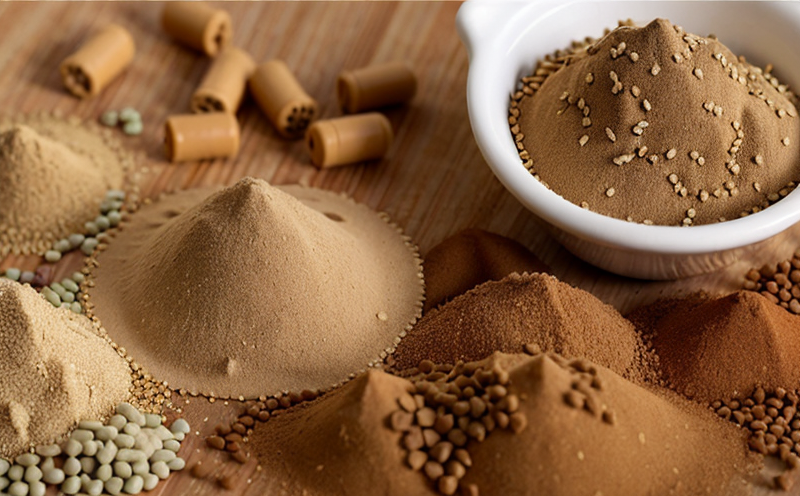Clindamycin Residue Testing in Animal Feed
Clindamycin is a broad-spectrum antibiotic used primarily to treat bacterial infections. In agriculture and forestry, clindamycin can be administered to animals for therapeutic purposes but must not exceed prescribed limits due to potential risks when present in animal feed or meat products.
The presence of clindamycin residues in animal feed can lead to several concerns:
- It may affect the quality and safety of animal-derived food products, leading to health risks for consumers.
- Residues can alter the natural microbiome of animals, potentially leading to antibiotic resistance.
- Regulatory bodies worldwide enforce strict residue limits to ensure public health and maintain consumer confidence in agricultural produce.
Eurolab offers comprehensive clindamycin residue testing services tailored for the agricultural sector. Our expertise ensures accurate detection, quantification, and reporting of residues in animal feed. This service is crucial for maintaining compliance with international standards and ensuring product safety.
Our dedicated team utilizes advanced analytical techniques to detect even trace amounts of clindamycin. We employ liquid chromatography tandem mass spectrometry (LC-MS/MS) which provides high sensitivity, selectivity, and accuracy in identifying the presence of clindamycin residues.
The testing process involves several critical steps:
- Sample preparation: Properly collecting feed samples is essential to ensure accurate results. Samples are homogenized and processed to extract clindamycin residues for analysis.
- Analytical method: Our laboratory adheres strictly to standardized methods such as ISO 17025, ensuring reliable and reproducible results.
- Data interpretation: Our experts analyze the data and provide a detailed report including concentrations and compliance with relevant regulations.
Eurolab's commitment to quality is reflected in our rigorous adherence to international standards:
| Standard | Description |
|---|---|
| ISO 17025 | Absence of bias, precision, and accuracy in testing. |
| ASTM E1687 | Standard practice for the analysis of veterinary drug residues in food products. |
Applied Standards
The clindamycin residue testing service at Eurolab strictly follows international standards to ensure reliable and accurate results. The primary standard used is ISO 17025, which ensures the competence of the laboratory in performing tests. Additionally, ASTM E1687 provides a robust framework for analyzing veterinary drug residues.
The testing process begins with sample preparation, where feed samples are collected, homogenized, and processed to extract clindamycin residues. The extraction method is critical as it directly impacts the accuracy of residue detection. Once extracted, the residues undergo a rigorous analytical phase using LC-MS/MS for precise quantification.
The results obtained from this process are then meticulously analyzed by our team of experts who ensure that all findings are reported accurately and comprehensively. These reports include detailed concentrations of clindamycin and compliance with relevant regulations, providing clients with clear insights into the safety and quality of their animal feed products.
Scope and Methodology
The scope of Eurolab's clindamycin residue testing service encompasses various types of animal feeds including pellets, mash, and premixes. Our methodology involves a multi-step process that starts with sample collection and preparation.
Sample preparation is crucial for ensuring accurate results. Feed samples are collected from different batches to ensure representativeness. These samples are then homogenized and processed using appropriate techniques to extract clindamycin residues. The extraction method used is critical as it directly impacts the accuracy of residue detection.
After sample preparation, the extracted residues undergo rigorous analytical processing using LC-MS/MS. This technique provides high sensitivity, selectivity, and accuracy in identifying even trace amounts of clindamycin. Our laboratory adheres strictly to standardized methods such as ISO 17025, ensuring reliable and reproducible results.
Data interpretation is the final step where our experts analyze the data obtained from the analytical process. This involves reviewing the concentration levels of clindamycin and comparing them with relevant regulatory limits. The results are then reported in a detailed manner including concentrations and compliance with relevant regulations, providing clients with clear insights into the safety and quality of their animal feed products.
Eurolab Advantages
Eurolab stands out in the field of clindamycin residue testing for several key reasons:
- Expertise: Our team comprises highly skilled professionals with extensive experience in agricultural and forestry testing.
- State-of-the-Art Equipment: We utilize cutting-edge equipment to ensure precise and accurate results.
- Comprehensive Reporting: Detailed reports including concentrations and compliance with relevant regulations are provided for clients.
- Regulatory Compliance: Adherence to international standards ensures reliable and reproducible test outcomes.
Our commitment to quality is further reflected in our rigorous adherence to ISO 17025, ensuring the competence of our laboratory in performing tests accurately. By choosing Eurolab for your clindamycin residue testing needs, you can be confident that you are partnering with a reliable and experienced organization dedicated to maintaining the highest standards in agricultural and forestry practices.





